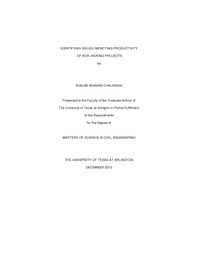
ATTENTION: The works hosted here are being migrated to a new repository that will consolidate resources, improve discoverability, and better show UTA's research impact on the global community. We will update authors as the migration progresses. Please see MavMatrix for more information.
Show simple item record
| dc.contributor.author | Chaurasia, Bhaumi Bhavan | en_US |
| dc.date.accessioned | 2013-03-20T19:12:23Z | |
| dc.date.available | 2013-03-20T19:12:23Z | |
| dc.date.issued | 2013-03-20 | |
| dc.date.submitted | January 2012 | en_US |
| dc.identifier.other | DISS-12056 | en_US |
| dc.identifier.uri | http://hdl.handle.net/10106/11599 | |
| dc.description.abstract | Jacking is a trenchless construction technique used for installing underground pipeline system. Jacking method is more widely used for upgrading under capacity culverts and drainage structures under roads and railroad tracks. Also, this method is used for installing underground pipelines such as watermains, sewers etc.in populated and developed urban areas. In this method, culverts (segments) are installed through the ground from an entry shaft to an exit shaft. During the excavation and spoil removal processes, workers are required to be inside the pipe, this is essentially what separates pipe jacking trenchless construction method from microtunneling technology. The minimum recommended diameter for pipes installed by jacking is 42 in. as it may not be possible for a person to enter smaller diameter pipes.Pipe/box jacking projects often have to face schedule delays or loss of productivity due to inherent uncertainties in identifying unmarked under laid structures, type of soil and groundwater conditions. The contractor usually relies on the judgments, from experienced engineers and experts in forecasting productivity. This leads to development of imprecision cost estimates, and as a result, bidding price for box jacking projects is usually kept on a higher side. The main objective of this study is to identify and quantify productivity related issues in box jacking trenchless construction method based on case studies and the expert opinion of contactors, engineers and various Department of Transportation's (DOT'S) professionals involved in pipe/box jacking trenchless construction operations, using Analytic Hierarchy Process (AHP) method to rank the opinions. This study identifies six (traffic control, safety & security, availability of box storage & handling, type of spoil removal system, size of box & weight of box) factors and parameters that contractors and engineers can consider to avoid delays and improve jacking productivity. Ranking of these factors is expected to help in improving the productivity of the box jacking process by planning and executing in a more efficient manner. This research builds up the basics for modeling box jacking productivity operation during various conditions. | en_US |
| dc.description.sponsorship | Najafi, Mohammad | en_US |
| dc.language.iso | en | en_US |
| dc.publisher | Civil & Environmental Engineering | en_US |
| dc.title | Identifying Issues Impacting Productivity Of Box Jacking Projects | en_US |
| dc.type | M.S. | en_US |
| dc.contributor.committeeChair | Najafi, Mohammad | en_US |
| dc.degree.department | Civil & Environmental Engineering | en_US |
| dc.degree.discipline | Civil & Environmental Engineering | en_US |
| dc.degree.grantor | University of Texas at Arlington | en_US |
| dc.degree.level | masters | en_US |
| dc.degree.name | M.S. | en_US |
Files in this item
- Name:
- Chaurasia_uta_2502M_12056.pdf
- Size:
- 3.295Mb
- Format:
- PDF
This item appears in the following Collection(s)
Show simple item record


